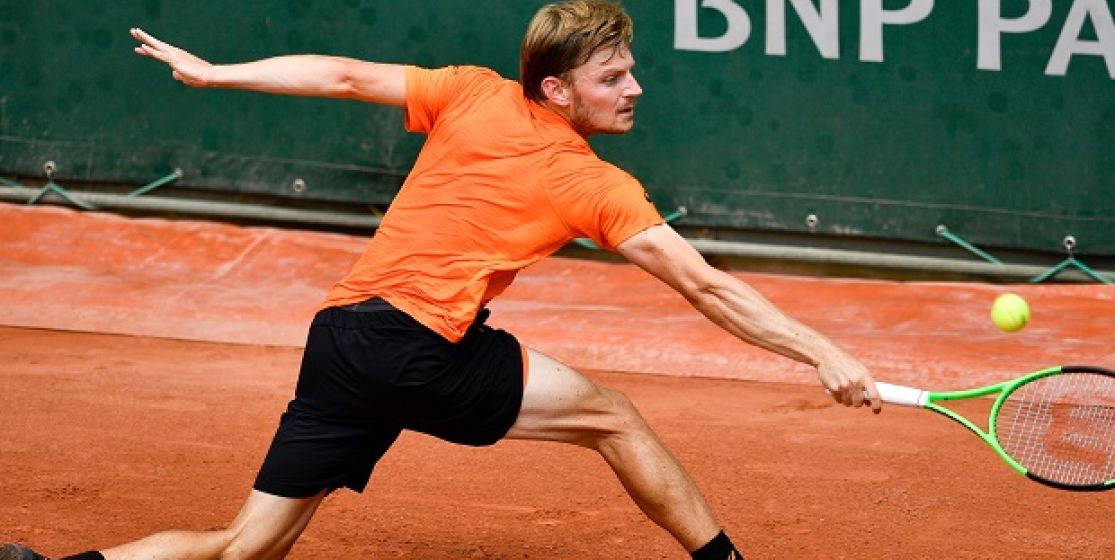Injured after after having his foot stuck in a tarpaulin during the third round of Roland-Garros, David Goffin is still annoyed : according to him, the tarpaulin had nothing to do here, and the surface at the back of the court would be too short to insure the players’ security. A false polemic ?
It’s what you call a stupid injury. Dominated by Horacio Zeballos in the rally, David Goffin didn’t want to give his opponent any ground. Even if it meant that he had to run to get balls which arrived far, very far from the limits of the courts. On one of his opponent’s backhands, the Belgian, who was completely outplayed, still managed to hit the ball at the very end of his run…except that he injured his right ankle, which got stuck under the tarpaulin which is usually deployed when the rain starts to fall, and which remains at the back of the court. The result : a fall, a big edema which fairly looked like a sprain, and a withdrawal which took him out of Roland-Garros, in the third round. On top of that, he’ll be out of the courts for at least two weeks, and there are some doubts regarding his presence at Wimbledon. Without forgetting a polemic concerning the amount of space offered to the players at the back of the courts, knowing that Gilles Muller went through the same troubles a couple of days before on the Court 1, and had to withdraw from the doubles.
After the match, Thierry Van Cleemput, the world number 12’s coach, mentioned the issue during his press conference : « The question of the tarpaulin is a real one…I think that the staff at Roland-Garros is professional, and that it’s asking itself the good questions. Actions will surely be taken to improve the players’ security. » A question which shouldn’t even exist, according to Jacques Simeon, the manager of Courts Simeon ( a company which specializes in creating and renovating tennis courts) : « Starting an argument because he fell on a tarpaulin is ridiculous. The explanation is quite simple : tennis has evolved a lot in the last 20 years, and we now have athletes which are quite extraordinary and who try to hit any possible ball back, even if that means they have to jump on walls. Goffin tried, he fell, too bad for him ! It could have happened in Melbourne or elsewhere. The criticism is not acceptable. He took a risk, it’s his responsibility if he injured himself. He has no right to criticize the organizers. » Especially as, on a legal aspect, the court of the Suzanne-Lenglen (where Goffin got injured) is irreproachable. The surface between the baseline and the stands is has to measure at least 6,40 meters. If this distance is longer in Grand Slam tournaments, its eight meters long on the Suzanne-Lenglen. The tarpaulin covers approximately half a meter. Goffin tripped on an object located 7,5 meters behind him. The argument was expressed by Guy Forget, the director of the tournament, to answer all the criticism : « The player has to adapt to the limits of the court, and David knows that. It’s just bad luck (…) A tennis court has its limits, in New York, in London, in Melbourne, everywhere, it’s not a football pitch. These days, the players’ athletic qualities allow them to reach some impossible balls. »
« It’s just like bumping into the umpire’s chair »
Rafael Nadal, on his side, also had a word to say in the debate, as he showed his support for Goffin : « I’ve always thought that this tarpaulin was dangerous and that it wasn’t put in the right place », he said. Except that « you can’t put it anywhere else », according to Jacques Simeon. Or else, you’d have to invent a crazy system with a hatch which opens up whenever it rains. » Forget pretty much said the same thing : « You have to put these tarpaulins somewhere, whether it is at the back of the courts, or on the sides, like at Wimbledon. Everyone’s happy when we can unfold them quickly when it’s raining (…). Of course, the tarpaulins are even further back on the central court, but they’re also way closer on some smaller, less important courts. » Before Simeon adds : « In any case, if the courts are this huge at Roland, it’s mainly to put the furniture at the right place. He’s not the first player to trip over something. It’s just like bumping into the umpire’s chair. » And that’s where we notice the futility of sparking a debate around the tarpaulins : in reality, the tarpaulin is part of the furniture, just like the advertising boards or the umpire’s chair. Pointing it out as a special case isn’t really acceptable.
In these conditions, couldn’t we just imagine making the courts bigger ? Questioned about the incident during his press conference, Roberto Bautista-Agut said it was the optimal solution. Especially at Roland-Garros : « Playing on clay requires more surface. This tarpaulin is placed here in case it rains, but we lose some of our playing surface. » However, Jacques Simeon quickly shuts him down : « Today, we shouldn’t make the courts bigger just because the game has evolved. You have players who are playing doubles on small courts, and they’re doing just fine. This idea is not acceptable. Making the courts bigger wouldn’t solve the problem : you’d still have players who would bump into things at the back of the court. » It’s up to the eccentric players to evaluate the risks they’re taking.



.jpg)



